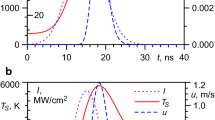Abstract
This paper describes the study of the effect of spatial inhomogeneity of surface temperature on the size of a crater forming in the case of pulsed laser ablation. It is assumed that the surface temperature is linearly dependent on laser radiation energy. Analytical expressions determining the effective radius of an evaporation region, characteristic temperatures of the surface on which evaporation occurs, and evaporation depths in the case of the Gaussian distribution of laser radiation energy are derived. It is shown that the analytical dependences obtained are in good agreement with known numerical calculation results.
Similar content being viewed by others
References
D. Bhattacharya, R. K. Singh, and P. H. Holloway, “Laser Target Interactions during Pulsed Laser Deposition of Superconducting Thin Films,” J. Appl. Phys. 70 (10), 5433–5439 (1991).
R. K. Singh and J. Viatella, “Estimation of Plasma Absorption Effects during Pulsed Laser Ablation of High–Critical–Temperature Superconductors,” J. Appl. Phys. 75 (2), 1204–1206 (1994).
S. Fähler and H.–U. Krebs, “Calculations and Experiments of Material Removal and Kinetic Energy during Pulsed Laser Ablation of Metals,” Appl. Surf. Sci. 96–98, 61–65 (1996).
V. N. Tokarev, J. G. Lunney, W. Marine, and M. Sentis, “Analytical Thermal Model of Ultraviolet Laser Ablation with Single–Photon Absorption in the Plume,” J. Appl. Phys. 78 (2), 1241–1246 (1995).
J. R. Ho, C. P. Grigoropoulos, and J. A. C. Humphrey, “Computational Study of Heat Transfer and Gas Dynamics in the Pulsed Laser Evaporation of Metals,” J. Appl. Phys. 78 (7), 4696–4709 (1995).
A. V. Bulgakov and N. M. Bulgakova, “Thermal Model of Pulsed Laser Ablation under the Conditions of Formation and Heating of a Radiation–Absorbing Plasma,” Quant. Electron. 29 (5) 433–437 (1999).
S. Tosto, “Modeling and Computer Simulation of Pulsed–Laser–Induced Ablation,” Appl. Phys. A 68, 439–446 (1999).
T. Li, Q. Lou, J. Dong, et al., “Ablation of Cobalt with Pulsed UV Laser Radiation,” Appl. Surf. Sci. 172, 356–365 (2001).
N. M. Bulgakova and A. V. Bulgakov, “Pulsed Laser Ablation of Solids: Transition from Normal Vaporization to Phase Explosion,” Appl. Phys. A 73, 199–208 (2001).
D. Marla, U. V. Bhandarkar, and S. S. Joshi, “A Model of Laser Ablation with Temperature–Dependent Material Properties, Vaporization, Phase Explosion and Plasma Shielding,” Appl. Phys. A 116, 273–285 (2014).
O. A. Bulgakova, N. M. Bulgakova, and V. P. Zhukov, “A Model of Nanosecond Laser Ablation of Compound Semiconductors Accounting for Non–Congruent Vaporization,” Appl. Phys. A 101, 53–59 (2010).
G. Dumitru, V. Romano, and H. P. Weber, “Model and Computer Simulation of Nanosecond Laser Material Ablation,” Appl. Phys. A 79, 1225–1228 (2004).
N. Mullenix and A. Povitsky, “Comparison of 1–D and 2–D Coupled Models of Gas Dynamics and Heat Transfer for the Laser Ablation of Carbon,” J. Comput. Theor. Nanosci. 3, 1–12 (2006).
M. Shusser, “Two–Dimensional Effects in Laser Ablation of Carbon,” Numer. Heat Transfer. A 56, 459–477 (2009).
N. A. Vasantgadkar, U. V. Bhandarkar, and S. S. Joshi, “A Finite Element Model to Predict the Ablation Depth in Pulsed Laser Ablation,” Thin Solid Films 519, 1421–1430 (2010).
S. Ghalamdaran, P. Parvin, M. J. Torkamany, and J. S. Zadeh, “Two–Dimensional Simulation of Laser Ablation with 235 Nanosecond Pulses,” J. Laser Appl. 26, 012009(2014).
S. Sinha, “Nanosecond Laser Ablation for Pulsed Laser Deposition of Yttria,” Appl. Phys. A 112, 855–862 (2013).
A. A. Morozov, “Analytical Formula for Interpretation of Time–of–Flight Distributions for Neutral Particles under Pulsed Laser Evaporation in Vacuum,” J. Phys. D: Appl. Phys. 48 (19), 195501 (2015).
D. Sibold and H.M. Urbassek, “Effect of Gas–Phase Collisions in Pulsed–Laser Desorption: A Three–Dimensional Monte Carlo Simulation Study,” J. Appl. Phys. 73 (12), 8544–8551 (1993).
T. E. Itina, V. N. Tokarev, W. Marine, and M. Autric, “Monte Carlo Simulation Study of the Effects of Nonequilibrium Chemical Reactions During Pulsed Laser Desorption,” J. Chem. Phys. 106 (21), 8905–8912 (1997).
N. M. Bulgakova, M. Yu. Plotnikov, and A. K. Rebrov, “DSMC Study of the Expansion of Laser Vaporization Products,” Teplofiz. Aeromekh. 5 (3), 421–429 (1998) [Thermophys. Aeromech. 5 (3), 385–392 (1998)].
N. Yu. Bykov and G. A. Lukianov, “Vapor Outflow into Vacuum from a Pulse Source of Moderate Intensity,” Teplofiz. Aeromekh. 9 (2), 247–257 (2002) [Thermophys. Aeromech., No. 2, 235–245 (2002)].
A. A. Morozov, A. B. Evtushenko, and A. V. Bulgakov, “Gas–Dynamic Acceleration of Laser–Ablation Plumes: Hyperthermal Particle Energies under Thermal Vaporization,” Appl. Phys. Lett. 106 (5), 054107 (2015).
N. Y. Bykov, N. M. Bulgakova, A. V. Bulgakov, and G. A. Loukianov, “Pulsed Laser Ablation of Metals in Vacuum: DSMC Study versus Experiment,” Appl. Phys. A 79, 1097–1100 (2004).
N. M. Bulgakova, A. V. Bulgakov, and L. P. Babich, “Energy Balance of Pulsed Laser Ablation: Thermal Model Revised,” Appl. Phys. A 79, 1323–1326 (2004).
A. V. Kirillin, M. D. Kovalenko, M. A. Sheindlin, and V. S. Zhivopistsev, “Experimental Study of Carbon Vapor Pressure in a Temperature Range of 5000–7000 K with the Use of a Stationary Laser Heating,” Teplofiz. Vysok. Temp. 23 (4), 699–706 (1985).
K. Boboridis, G. Pottlacher, and H. Jager, “Determination of the Critical Point of Gold,” Int. J. Thermophys. 20, 1289–1297 (1999).
Physical Quantities, Ed. by I. S. Grigor’ev and E. Z. Meilikhova (Energoatomizdat, Moscow, 1991) [in Russian].
V. Morel, A. Bultel, and B. G. Chéron, “The Critical Temperature of Aluminum,” Int. J. Thermophys. 30, 1853–1863 (2009).
Encyclopaedia of Chemistry Eds. N. S. Zefirova (Bol’shaya Ross. Entsiklopediya, Moscow, 1995) [in Russian].
Author information
Authors and Affiliations
Corresponding author
Additional information
Original Russian Text © A.A. Morozov.
Translated from Prikladnaya Mekhanika i Tekhnicheskaya Fizika, Vol. 59, No. 5, pp. 78–86, September–October, 2018.
Rights and permissions
About this article
Cite this article
Morozov, A.A. Analytical Model for Determining The Effective Size of an Evaporation Region in Pulsed Laser Ablation. J Appl Mech Tech Phy 59, 834–841 (2018). https://doi.org/10.1134/S0021894418050097
Received:
Published:
Issue Date:
DOI: https://doi.org/10.1134/S0021894418050097




